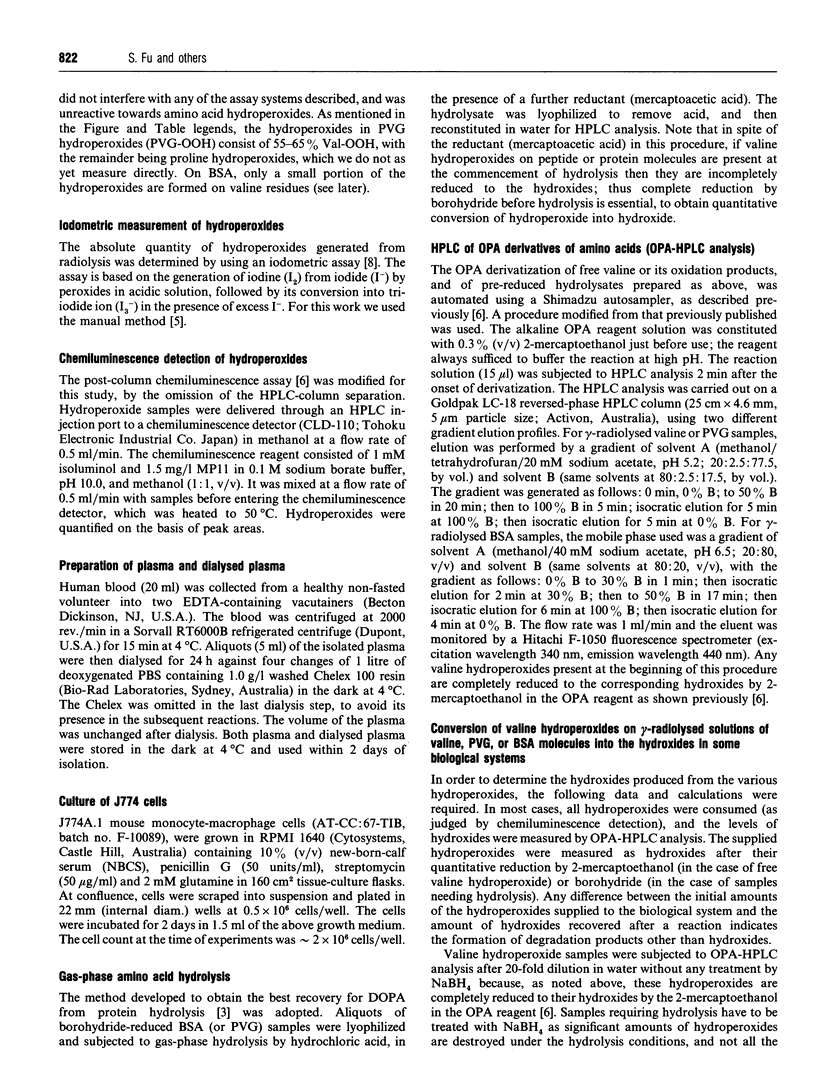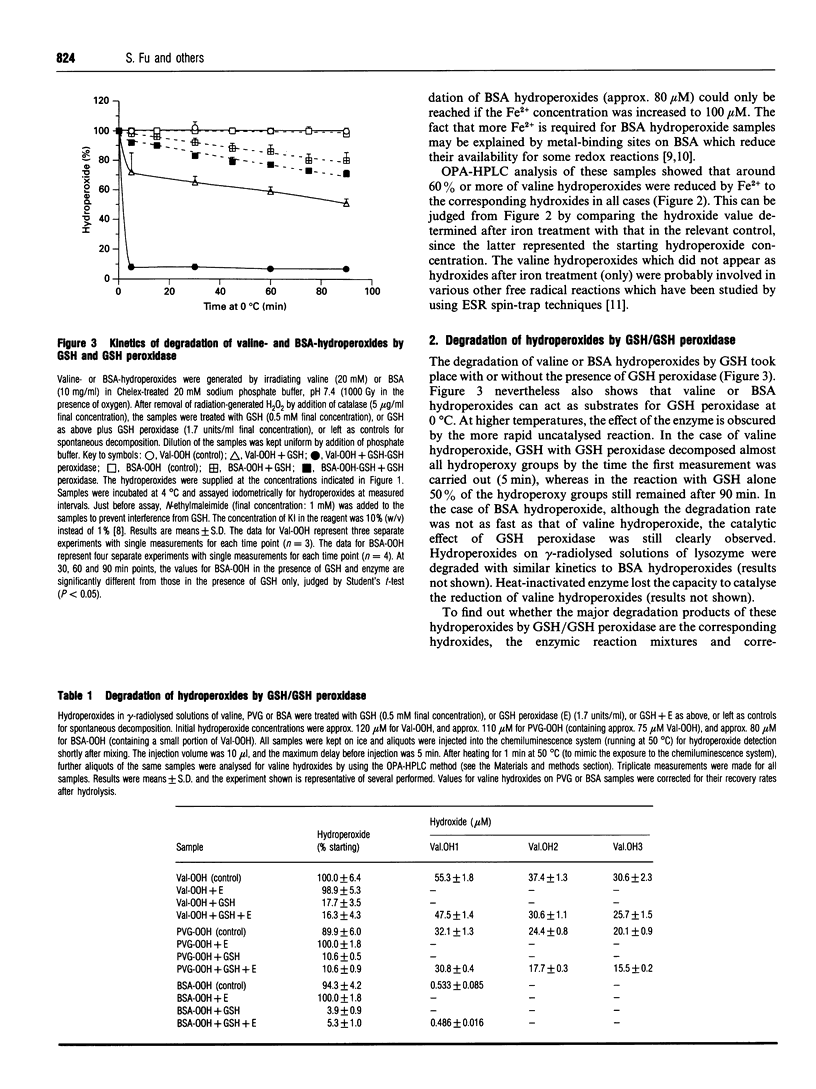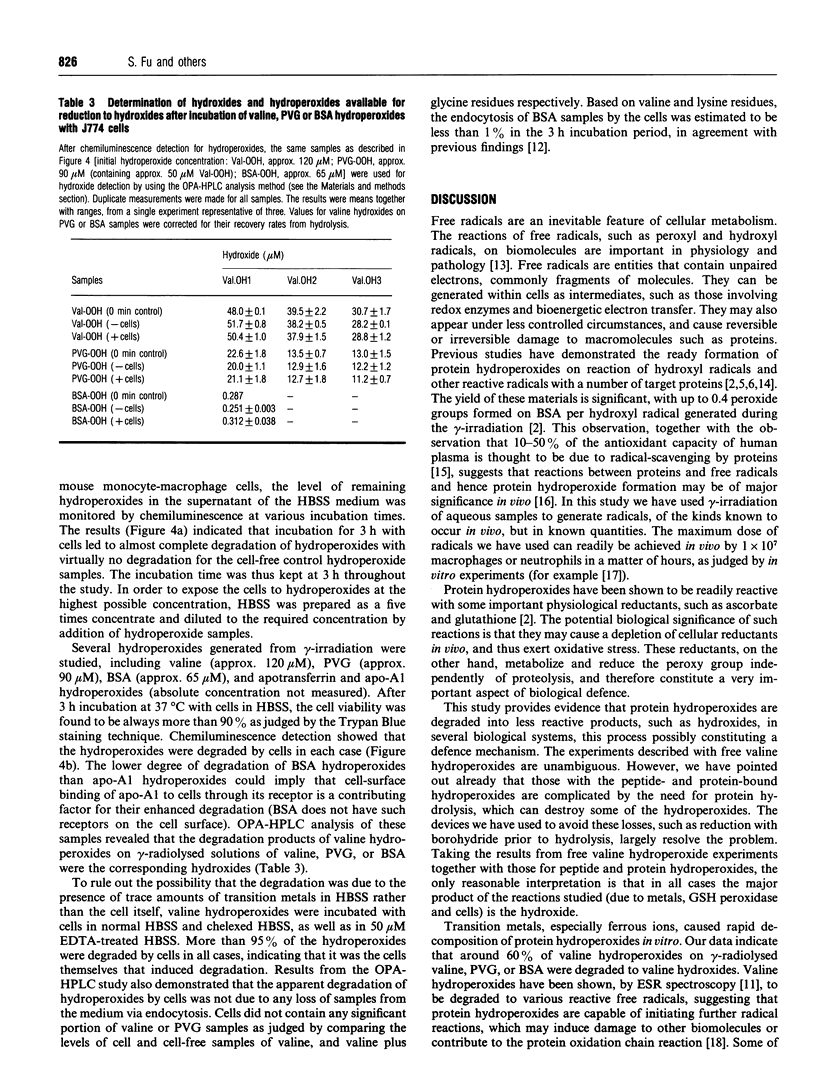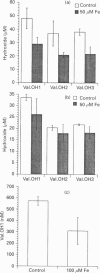Abstract
In the course of searching for a suitable marker for studying protein oxidation, we have successfully elucidated the structures of three valine hydroperoxides, i.e. beta-hydroperoxyvaline, (2S,3S)-gamma-hydroperoxyvaline and (2S,3R)-gamma-hydroperoxyvaline, which are novel products of protein oxidation. The corresponding valine hydroxides were obtained by sodium borohydride reduction [Fu, Hick, Sheil and Dean (1995) Free Rad. Biol. Med. 19, 281-292]. We hypothesized that valine hydroxides might be the major biological degradation products of valine hydroperoxides and, as such, could be useful markers for the study of protein oxidation in vivo. The aim of this study was to investigate the fate of valine hydroperoxide in selected biological systems by the use of chemiluminescence detection of hydroperoxides and HPLC analysis of O-phthaldialdehyde derivatives of amino acid residues. The degradation of hydroperoxides present on gamma-radiolysed solutions of valine, Pro-Val-Gly, or BSA occurred in the presence of: (1) transition metals (Fe2+, Fe3+, or Cu2+), (2) the detoxifying enzyme GSH peroxidase, (3) human plasma, and (4) J774 mouse monocyte macrophage cells. The major degradation product of valine hydroperoxide recovered in each case was found to be a valine hydroxide. These results suggest that valine hydroxide (derived from the hydroperoxide) may well be a useful in vivo marker for studying protein damage under oxidative stress.
Full text
PDF






Images in this article
Selected References
These references are in PubMed. This may not be the complete list of references from this article.
- Davies M. J., Fu S., Dean R. T. Protein hydroperoxides can give rise to reactive free radicals. Biochem J. 1995 Jan 15;305(Pt 2):643–649. doi: 10.1042/bj3050643. [DOI] [PMC free article] [PubMed] [Google Scholar]
- Dean R. T., Gieseg S., Davies M. J. Reactive species and their accumulation on radical-damaged proteins. Trends Biochem Sci. 1993 Nov;18(11):437–441. doi: 10.1016/0968-0004(93)90145-d. [DOI] [PubMed] [Google Scholar]
- Faghihi Shirazi M., Aronson N. N., Jr, Dean R. T. Temperature dependence of certain integrated membrane functions in macrophages. J Cell Sci. 1982 Oct;57:115–127. doi: 10.1242/jcs.57.1.115. [DOI] [PubMed] [Google Scholar]
- Finkel T. H., Pabst M. J., Suzuki H., Guthrie L. A., Forehand J. R., Phillips W. A., Johnston R. B., Jr Priming of neutrophils and macrophages for enhanced release of superoxide anion by the calcium ionophore ionomycin. Implications for regulation of the respiratory burst. J Biol Chem. 1987 Sep 15;262(26):12589–12596. [PubMed] [Google Scholar]
- Fu S., Hick L. A., Sheil M. M., Dean R. T. Structural identification of valine hydroperoxides and hydroxides on radical-damaged amino acid, peptide, and protein molecules. Free Radic Biol Med. 1995 Sep;19(3):281–292. doi: 10.1016/0891-5849(95)00021-o. [DOI] [PubMed] [Google Scholar]
- Gebicki S., Gebicki J. M. Formation of peroxides in amino acids and proteins exposed to oxygen free radicals. Biochem J. 1993 Feb 1;289(Pt 3):743–749. doi: 10.1042/bj2890743. [DOI] [PMC free article] [PubMed] [Google Scholar]
- Gieseg S. P., Simpson J. A., Charlton T. S., Duncan M. W., Dean R. T. Protein-bound 3,4-dihydroxyphenylalanine is a major reductant formed during hydroxyl radical damage to proteins. Biochemistry. 1993 May 11;32(18):4780–4786. doi: 10.1021/bi00069a012. [DOI] [PubMed] [Google Scholar]
- Grant A. J., Jessup W., Dean R. T. Accelerated endocytosis and incomplete catabolism of radical-damaged protein. Biochim Biophys Acta. 1992 Apr 7;1134(3):203–209. doi: 10.1016/0167-4889(92)90177-d. [DOI] [PubMed] [Google Scholar]
- Grant A. J., Jessup W., Dean R. T. Inefficient degradation of oxidized regions of protein molecules. Free Radic Res Commun. 1993;18(5):259–267. doi: 10.3109/10715769309147493. [DOI] [PubMed] [Google Scholar]
- Mander E. L., Dean R. T., Stanley K. K., Jessup W. Apolipoprotein B of oxidized LDL accumulates in the lysosomes of macrophages. Biochim Biophys Acta. 1994 Apr 14;1212(1):80–92. doi: 10.1016/0005-2760(94)90192-9. [DOI] [PubMed] [Google Scholar]
- Marx G., Chevion M. Site-specific modification of albumin by free radicals. Reaction with copper(II) and ascorbate. Biochem J. 1986 Jun 1;236(2):397–400. doi: 10.1042/bj2360397. [DOI] [PMC free article] [PubMed] [Google Scholar]
- Neuzil J., Gebicki J. M., Stocker R. Radical-induced chain oxidation of proteins and its inhibition by chain-breaking antioxidants. Biochem J. 1993 Aug 1;293(Pt 3):601–606. doi: 10.1042/bj2930601. [DOI] [PMC free article] [PubMed] [Google Scholar]
- Simpson J. A., Dean R. T. Stimulatory and inhibitory actions of proteins and amino acids on copper-catalysed free radical generation in the bulk phase. Free Radic Res Commun. 1990;10(4-5):303–312. doi: 10.3109/10715769009149899. [DOI] [PubMed] [Google Scholar]
- Simpson J. A., Narita S., Gieseg S., Gebicki S., Gebicki J. M., Dean R. T. Long-lived reactive species on free-radical-damaged proteins. Biochem J. 1992 Mar 15;282(Pt 3):621–624. doi: 10.1042/bj2820621. [DOI] [PMC free article] [PubMed] [Google Scholar]
- Stadtman E. R. Oxidation of free amino acids and amino acid residues in proteins by radiolysis and by metal-catalyzed reactions. Annu Rev Biochem. 1993;62:797–821. doi: 10.1146/annurev.bi.62.070193.004053. [DOI] [PubMed] [Google Scholar]
- Wayner D. D., Burton G. W., Ingold K. U., Barclay L. R., Locke S. J. The relative contributions of vitamin E, urate, ascorbate and proteins to the total peroxyl radical-trapping antioxidant activity of human blood plasma. Biochim Biophys Acta. 1987 Jun 22;924(3):408–419. doi: 10.1016/0304-4165(87)90155-3. [DOI] [PubMed] [Google Scholar]





